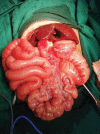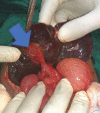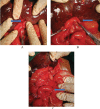Biliary Atresia Splenic Malformation: A Case Report from A Tertiary Centre in West Africa and the Lessons Learnt
- PMID: 36923807
- PMCID: PMC10010588
- DOI: 10.4103/jwas.jwas_195_22
Biliary Atresia Splenic Malformation: A Case Report from A Tertiary Centre in West Africa and the Lessons Learnt
Abstract
Biliary atresia (BA) is a rare disease characterised by biliary obstruction of unknown origin that presents in the neonatal period. It is classified into syndromic with various congenital anomalies and non-syndromic (isolated anomaly). We present a case of syndromic BA associated with polysplenia and intestinal malrotation, discovered incidentally during the Kasai procedure. The small intestine was found to be non-rotated with the duodenojejunal junction to the right of the vertebral column. The presence of accessory spleens was noted. Kasai portoenterostomy and Ladd's procedure were performed. The patient had an uneventful postoperative course with the passage of cholic stool from the third postoperative day. At the seventh-month follow-up, the stool remained cholic. A multidisciplinary approach in the care of babies with BA and long-term follow-up is crucial for a successful outcome.
Keywords: BASM; Cholestatic jaundice; biliary atresia; intestinal malrotation; polysplenia.
Copyright: © 2023 Journal of West African College of Surgeons.
Conflict of interest statement
There are no conflicts of interest.
Figures





References
-
- Davenport M, Savage M, Mowat AP, Howard ER. Biliary atresia splenic malformation syndrome: An etiologic and prognostic subgroup. Surgery. 1993;113:662–8. - PubMed
Publication types
LinkOut - more resources
Full Text Sources
